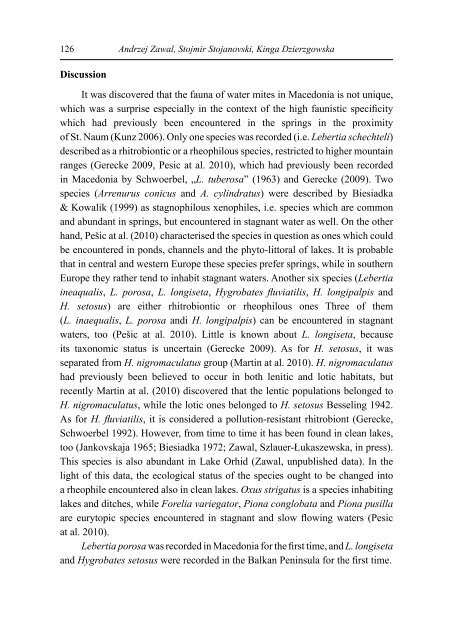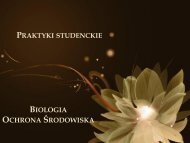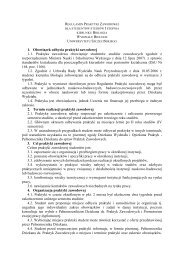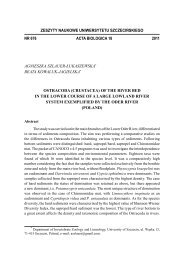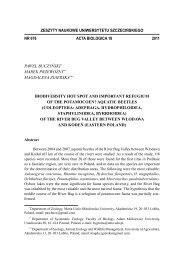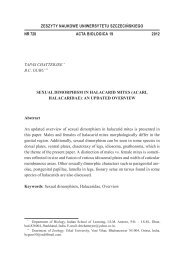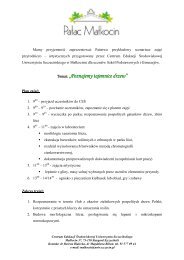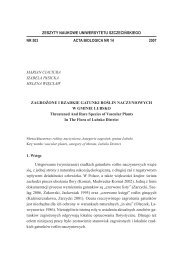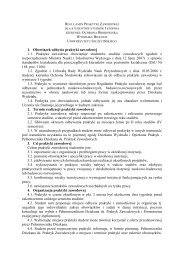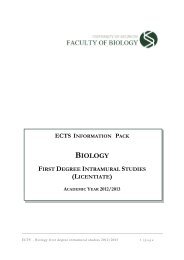7 The water mite fauna (Hydrachnidia) from three springs in ...
7 The water mite fauna (Hydrachnidia) from three springs in ...
7 The water mite fauna (Hydrachnidia) from three springs in ...
Create successful ePaper yourself
Turn your PDF publications into a flip-book with our unique Google optimized e-Paper software.
126 Andrzej Zawal, Stojmir Stojanovski, K<strong>in</strong>ga Dzierzgowska<br />
Discussion<br />
It was discovered that the <strong>fauna</strong> of <strong>water</strong> <strong>mite</strong>s <strong>in</strong> Macedonia is not unique,<br />
which was a surprise especially <strong>in</strong> the context of the high faunistic specificity<br />
which had previously been encountered <strong>in</strong> the <strong>spr<strong>in</strong>gs</strong> <strong>in</strong> the proximity<br />
of St. Naum (Kunz 2006). Only one species was recorded (i.e. Lebertia schechteli)<br />
described as a rhitrobiontic or a rheophilous species, restricted to higher mounta<strong>in</strong><br />
ranges (Gerecke 2009, Pesic at al. 2010), which had previously been recorded<br />
<strong>in</strong> Macedonia by Schwoerbel, „L. tuberosa” (1963) and Gerecke (2009). Two<br />
species (Arrenurus conicus and A. cyl<strong>in</strong>dratus) were described by Biesiadka<br />
& Kowalik (1999) as stagnophilous xenophiles, i.e. species which are common<br />
and abundant <strong>in</strong> <strong>spr<strong>in</strong>gs</strong>, but encountered <strong>in</strong> stagnant <strong>water</strong> as well. On the other<br />
hand, Pešic at al. (2010) characterised the species <strong>in</strong> question as ones which could<br />
be encountered <strong>in</strong> ponds, channels and the phyto-littoral of lakes. It is probable<br />
that <strong>in</strong> central and western Europe these species prefer <strong>spr<strong>in</strong>gs</strong>, while <strong>in</strong> southern<br />
Europe they rather tend to <strong>in</strong>habit stagnant <strong>water</strong>s. Another six species (Lebertia<br />
<strong>in</strong>eaqualis, L. porosa, L. longiseta, Hygrobates fl uviatilis, H. longipalpis and<br />
H. setosus) are either rhitrobiontic or rheophilous ones Three of them<br />
(L. <strong>in</strong>aequalis, L. porosa andi H. longipalpis) can be encountered <strong>in</strong> stagnant<br />
<strong>water</strong>s, too (Pešic at al. 2010). Little is known about L. longiseta, because<br />
its taxonomic status is uncerta<strong>in</strong> (Gerecke 2009). As for H. setosus, it was<br />
separated <strong>from</strong> H. nigromaculatus group (Mart<strong>in</strong> at al. 2010). H. nigromaculatus<br />
had previously been believed to occur <strong>in</strong> both lenitic and lotic habitats, but<br />
recently Mart<strong>in</strong> at al. (2010) discovered that the lentic populations belonged to<br />
H. nigromaculatus, while the lotic ones belonged to H. setosus Bessel<strong>in</strong>g 1942.<br />
As for H. fl uviatilis, it is considered a pollution-resistant rhitrobiont (Gerecke,<br />
Schwoerbel 1992). However, <strong>from</strong> time to time it has been found <strong>in</strong> clean lakes,<br />
too (Jankovskaja 1965; Biesiadka 1972; Zawal, Szlauer-Łukaszewska, <strong>in</strong> press).<br />
This species is also abundant <strong>in</strong> Lake Orhid (Zawal, unpublished data). In the<br />
light of this data, the ecological status of the species ought to be changed <strong>in</strong>to<br />
a rheophile encountered also <strong>in</strong> clean lakes. Oxus strigatus is a species <strong>in</strong>habit<strong>in</strong>g<br />
lakes and ditches, while Forelia variegator, Piona conglobata and Piona pusilla<br />
are eurytopic species encountered <strong>in</strong> stagnant and slow flow<strong>in</strong>g <strong>water</strong>s (Pesic<br />
at al. 2010).<br />
Lebertia porosa was recorded <strong>in</strong> Macedonia for the first time, and L. longiseta<br />
and Hygrobates setosus were recorded <strong>in</strong> the Balkan Pen<strong>in</strong>sula for the first time.


